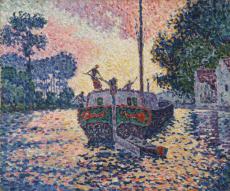


In 1883, Paul Signac was 20 years old and claimed only one teacher: Claude Monet (1840-1926). However, it was contact with a friend, Georges Seurat (1859-1891), whom he met at the Salon des Indépendants, which had been newly founded in 1884, that would help him develop his personal style and become, according to the term coined by another friend, the art critic Félix Fénéon, a ‘NeoImpressionist’. At the eighth and final exhibition of the Impressionist group in 1886, the canvases of the young painters, notably Seurat’s Un Dimanche à la Grande Jatte (Art Institute of Chicago), astonished viewers with their Divisionist technique. This consisted in basing oneself on the science of optics and thereby renouncing the mix of colours on the palette. This was substituted by small, point-like brushstrokes of pure colour juxtaposed on the canvas. In this way, the viewer’s eye was allowed to reconstitute this mix (for example, red + blue = violet, etc.). At the same time, the artist would also reproduce the effect of a neighbouring object on an object’s colour. This method, which had painters strongly advocating its scientific basis and denying the empirical and subjective approach of the Impressionists, conferred an incomparable brilliance to their canvases, winning over even Camille Pissarro (1830-1903), who in fact produced several Divisionist canvases. During the following years, Signac would go on to paint landscapes, seascapes and compositions with figures, firmly rooted in the contemporary world, successfully following this path alongside Seurat. The influence of a librarian-mathematician friend, Charles Henry (1859-1926), also encouraged these artists to analyse the expressivity of the line underlying the dynamic of their compositions. The premature death of Seurat in 1891 made Signac the leader of the movement and led him to publish, in 1899, a theoretical text entitled D’Eugène Delacroix au néo-impressionnisme, which would have a powerful impact on artists of that time.
Signac was, therefore, a painter who had fully mastered his art when he completed, in 1901, this small canvas, part of a series of paintings done, according to his habit, from studies in oils and watercolours. Signac worked on them mostly during the autumn of 1900, in the village of Samois, on the banks of the Seine, very close to Fontainebleau. Two canvases of the series were exhibited in 1902 at the Salon des Indépendants, to which Signac remained loyal and where, as its chairman, he was responsible for welcoming new talent. Compared to his Neo- Impressionist canvases painted in the 1880s, his brushstroke has become broader, creating a kind of vividly coloured mosaic. The contrasts occur in juxtapositions of blue and orange, blue and rose, and red and green, allowing the memory of the Midi – where Signac lived and painted in Saint-Tropez, a place he had discovered in 1892 – to float over the landscape of the Île-de-France. Based primarily on ‘calm’ horizontal lines, the composition comes alive with the dynamic and ‘joyous’ diagonal construction lines, according to Charles Henry’s principles, created by the unusual figure of a woman at the helm and the gesticulating sailors. A bemused Signac imparts his gentle sense of humour to this river scene. Like a good sailor – he had practised yachting all his life – he observed with precision the manoeuvres of the barge. He used the central motif of the composition again in a small etching in the shape of a fan which served as a tailpiece in the 1 September 1901 issue of the Revue blanche, one of the most influential avantgarde journals at the turn of the century. It was canvases such as Samois, le Chaland which influenced Henri Matisse’s development: in fact, Matisse (1869- 1954) painted during a stay with Signac in Saint- Tropez in 1904 one of the founding canvases of his career and of Fauvism, Luxe, Calme et Volupté (Paris, Musée d’Orsay), still imbued with the principles of Neo-Impressionism.
Samois, le Chaland numbers among its previous owners three remarkable art aficionados. The first one (Signac himself recorded the memory in his notes) was the famous Count Harry Kessler (1868- 1937), a German aristocrat raised in England, an aesthete and a Francophile who contributed, by supporting the architect Henry Van de Velde (1863- 1957), to the development of the small town of Weimar as a bastion of the avant-garde in the early 20th century. Kessler also possessed another canvas by Signac painted at Samois, which is now housed at the National Gallery in Prague, and thus, through these works, Neo-Impressionism was introduced to German art lovers and artists. The art sale of 1908 organised by the art dealer Eugène Druet, which comprised works by only the most contemporary artists and featured Samois, le Chaland, was, as the writer André Gide observed in his Journal, a veritable test of their increased notoriety. Later on, the painting became the property of Gaston Lévy (1893-1977), co-founder of the Monoprix store chain and a great lover of modern art. With close ties to Signac, he supported his project to paint the ports of France in watercolour in 1929, an ambitious enterprise which was impeded by the sponsor’s financial difficulties during the economic crisis of 1930, but which largely dominated the final years of Signac’s career.
He was training as an architect, but when he attended an exhibition of works by Claude Monet he decided on a career in painting. Together with fellow Neo-Impressionist Georges Seurat, he developed the Divisionist technique, which confers a sparkling luminosity to the canvas by juxtaposing pure colour applied in small points. He travelled extensively, painting mostly landscapes and seascapes. He also mastered watercolour, which came to occupy a prominent place in his oeuvre. He was president of the Société des Artistes Indépendants from 1908 until his death and encouraged many younger artists; he was the first to buy a painting by Henri Matisse.